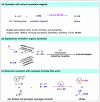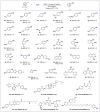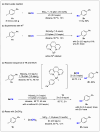Nickel-Catalyzed Reductive Cyanation of Aryl Halides and Epoxides with Cyanogen Bromide
- PMID: 39770100
- PMCID: PMC11678332
- DOI: 10.3390/molecules29246016
Nickel-Catalyzed Reductive Cyanation of Aryl Halides and Epoxides with Cyanogen Bromide
Abstract
Nitriles are valuable compounds because they have widespread applications in organic chemistry. This report details the nickel-catalyzed reductive cyanation of aryl halides and epoxides with cyanogen bromide for the synthesis of nitriles. This robust protocol underscores the practicality of using a commercially available and cost-effective cyanation reagent. A variety of aryl halides and epoxides featuring diverse functional groups, such as -TMS, -Bpin, -OH, -NH2, -CN, and -CHO, were successfully converted into nitriles in moderate-to-good yields. Moreover, the syntheses at gram-scale and application in late-stage cyanation of natural products and drugs reinforces its potentiality.
Keywords: cyanation; cyanogen bromide; nickel catalysis; nitriles; reductive coupling.
Conflict of interest statement
The authors declare no conflicts of interest.
Figures







Similar articles
-
Nickel-Catalyzed Cyanation of Aryl Halides.Molecules. 2025 Aug 20;30(16):3440. doi: 10.3390/molecules30163440. Molecules. 2025. PMID: 40871592 Free PMC article. Review.
-
Nickel-catalyzed cyanation reaction of aryl/alkenyl halides with alkyl isocyanides.Org Biomol Chem. 2022 Oct 26;20(41):8049-8053. doi: 10.1039/d2ob01240e. Org Biomol Chem. 2022. PMID: 36214214
-
Reductive cyanation of organic chlorides using CO2 and NH3 via Triphos-Ni(I) species.Nat Commun. 2020 Aug 14;11(1):4096. doi: 10.1038/s41467-020-17939-2. Nat Commun. 2020. PMID: 32796845 Free PMC article.
-
Recent advances and prospects in the palladium-catalyzed cyanation of aryl halides.RSC Adv. 2020 Sep 11;10(56):33683-33699. doi: 10.1039/d0ra05960a. eCollection 2020 Sep 10. RSC Adv. 2020. PMID: 35519018 Free PMC article. Review.
-
Nickel-Catalyzed Cyanation of Aryl Chlorides and Triflates Using Butyronitrile: Merging Retro-hydrocyanation with Cross-Coupling.Angew Chem Int Ed Engl. 2017 Dec 4;56(49):15693-15697. doi: 10.1002/anie.201707517. Epub 2017 Nov 7. Angew Chem Int Ed Engl. 2017. PMID: 28990266
Cited by
-
Nickel-Catalyzed Cyanation of Aryl Halides.Molecules. 2025 Aug 20;30(16):3440. doi: 10.3390/molecules30163440. Molecules. 2025. PMID: 40871592 Free PMC article. Review.
References
-
- Tathe A.B., Gupta V.D., Sekar N. Synthesis and Combined Experimental and Computational Investigations on Spectroscopic and Photophysical Properties of Red Emitting 3-styryl Coumarins. Dyes Pigment. 2015;119:49–55. doi: 10.1016/j.dyepig.2015.03.023. - DOI
-
- Jones L.H., Summerhill N.W., Swain N.A., Mills J.E. Aromatic Chloride to Nitrile Transformation: Medicinal and Synthetic Chemistry. Med. Chem. Commun. 2010;1:309–318. doi: 10.1039/C0MD00135J. - DOI
Grants and funding
LinkOut - more resources
Full Text Sources

